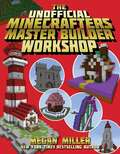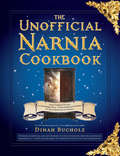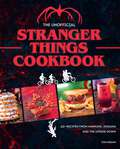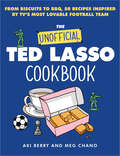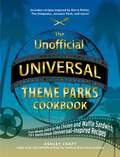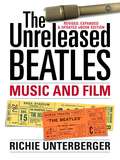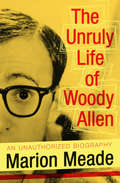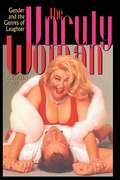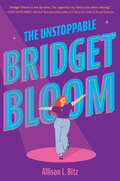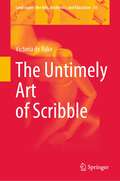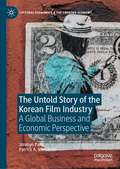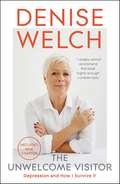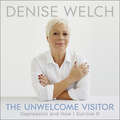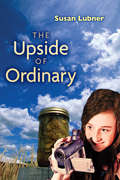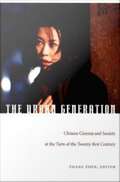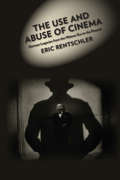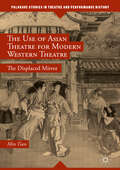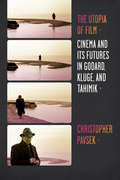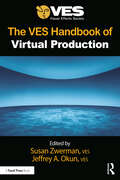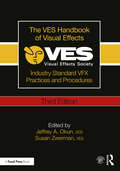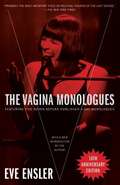- Table View
- List View
The Unofficial Minecrafters Master Builder Workshop
by Megan MillerThe Unofficial Minecrafters Master Builder Workshop is the fun and easy starting guide to making your own Minecraft builds! Helping you learn how to make all the cool builds you’ve seen online, this book comes packed with hundreds of step-by-step photos and instructions to make tinkering in your master building workshop simple! Find out all you need to know about tools, strategies, mining, and mobs to get you started on your Minecraft gaming adventure. Perfect for beginner to advanced Minecrafters who want to learn more! Includes hundreds of full-color photos to show every step of the way! Gets you thinking while building a world of fun! Break free from the standard designs and become the master builder you’ve always wanted to be with The Unofficial Minecrafters Master Builder Workshop!
The Unofficial Narnia Cookbook
by Dinah BucholzFrom the author of the New York Times bestselling and wildly popular The Unofficial Harry Potter Cookbook comes a new culinary and literary children's treat! Featuring all the delicious delicacies of The Chronicles of Narnia and many more besides, author Dinah Bucholz takes readers on a mouth-watering journey—from the Lamppost to the Castle at Cair Paravel. Included are recipes for: • Turkish Delight • Rich Plum Cake • Treacle Tart • Christmas Biscuits and many more!
The Unofficial Stranger Things Cookbook: (Pop Culture Cookbook, Demogorgon, Hellfire Club)
by Tom GrimmEat your way out of the Upside Down with this cookbook inspired by the world of Stranger Things. From comfort food straight from Mrs. Wheeler&’s table to fast food from the Starcourt Mall food court, this cookbook features all kinds of recipes that would fit right into both dimensions of 1980s Hawkins, Indiana. Open a portal to Hawkins, Indiana, with this totally rad cookbook inspired by food Mike, Lucas, Dustin, Max, Will, and Eleven would have eaten in 1980s Indiana. Like a ravenous Demogorgon, you can eat and drink your way out of the Upside Down from breakfast to happy hour, consuming hearty family dinners from the Wheeler's family kitchen or cheap eats made by Jim Hopper himself. Try Dr. Alexie&’s Favorite Slushie and dig into creepy Upside Down twists on classic recipes like Demogorgonzola, Stranger Wings, Upside Down Burger, and more! With full-color photography and enough recipes to fuel your own Hellfire Club, this is the perfect cookbook for Stranger Things fans. 60+ RECIPES TO TAKE YOU FROM BREAKFAST TO HAPPY HOUR: This cookbook will make you want to spend a whole day with the Party—start with Eleven&’s favorite waffle treats and wind down with a Cuba Libre or mocktail (your choice!) BACK TO THE 1980s: Dine on homemade comfort food, twists on Hopper&’s favorite microwaveable meals, and classic food court eats
The Unofficial Studio Ghibli Cookbook: 50+ Delicious Recipes Inspired by Your Favorite Japanese Animated Films
by Jessica YunBring some magic into your kitchen with this unofficial collection of Japanese recipes inspired by Hayao Miyazaki&’s most beloved films.Since 1985, Studio Ghibli has enchanted moviegoers with fantastic stories of adventure, magic, friendship, family, and most of all—the most delicious-looking animated food. Now you can create your own mouthwatering dishes with this book full of 50 unofficial, fan-created recipes! From tantalizing breakfasts and lunches to Japanese favorites like yakitori and onigiri, recipes include: Skillet bacon and eggs Ramen with &“haaaam&”! Herring and pumpkin pot pie Steamed red bean bao Salmon with beurre blanc sauce And more! Perfect for fans of Japanese anime, manga, and comfort food cooking!
The Unofficial Ted Lasso Cookbook: From Biscuits to BBQ, 50 Recipes Inspired by TV's Most Lovable Football Team
by Aki Berry Meg ChanoInspired by the beloved, Emmy Award–winning TV show Ted Lasso, a collection of 50 recipes, DIY ideas, and other Easter eggs for anyone who believes that Football is Life!Keep calm and carry on, the Unofficial Ted Lasso Cookbook is here. Perfect for fans in need of sweet treats to numb the sting of defeat, or those who agree that tea tastes like hot brown water, this collection of recipes will warm your heart and fill your stomach. Featuring delicious dishes from every corner of the Lassoverse, like:Pigs in Roy's BlankieTed’s Bullseye BBQ Pulled Pork SandwichSam’s Jollof Rice With ChickenCrown and Anchor Fish and ChipsDani's Cheeky Mexican PoncheDiamond Dogs’ HighballBELIEVE Cupcake SheetAnd of course, Biscuits With the Boss (along with instructions to make your own pink box)With recipes for every occasion—from afternoon teas to AFC Richmond tailgates—plus creative watch party ideas and stories, this cookbook will help you recreate the quirky, high-spirited world of Ted Lasso and welcome its infectious optimism into your own home.
The Unofficial Universal Theme Parks Cookbook: From Moose Juice to Chicken and Waffle Sandwiches, 75+ Delicious Universal-Inspired Recipes (Unofficial Cookbook)
by Ashley CraftBring the delicious food of the Universal Theme Parks right to your own home with these 75+ beloved recipes you can enjoy between trips.Bring the thrill of Universal straight to your kitchen with The Unofficial Universal Theme Parks Cookbook! From favorite snacks and main dishes to refreshing drinks and popular desserts, this book features more than 75 recipes for your favorite treats from Universal Studios Orlando, Universal&’s Island of Adventure, Universal&’s Volcano Bay, and Universal Studios Hollywood. You&’ll learn how to make: -The Big Pink from Lard Lad Donuts -Fish and Chips from The Three Broomsticks -Minion Banana Taffy from Super Silly Stuff -Moose Juice from Moose Juice, Goose Juice -Korean Beef Tacos from Bumblebee Man&’s -Unicorn Cupcakes from Minion Café -Pumpkin Juice from Hog&’s Head -And much more! Perfect for everyone from park hopping experts who miss those familiar flavors in between trips to fans who have yet to visit the parks, The Unofficial Universal Theme Parks Cookbook has all the recipes you&’ll need to make treats worthy of Homer Simpson, Harry Potter, and more!
The Unreleased Beatles
by Richie Unterberger"The Unreleased Beatles: Music and Film" is a mammoth 350,000-word guide to the incredible wealth of music the Beatles recorded that they did not release, as well as musical footage of the group that hasn't been made commercially available. This revised and expanded ebook edition adds about 30,000 words to the print edition, including coverage of all known material by the group that has gone into circulation since the book's original 2006 release. There is also updated information about the music and film detailed in the original edition, including the appearance of some previously unissued recordings on official releases. "The Unreleased Beatles: Music and Film" examines all of their unreleased studio outtakes, BBC radio recordings from 1962-65, live concert performances, home demos, private tapes, fan club Christmas recordings, and other informal recordings done outside of EMI studios that have escaped into circulation. Chronologically sequenced entries for all the Beatles' unreleased recordings of note from 1957 to 1970 are here, as well as all the unreleased Beatles musical video footage of note from 1961 to 1970. Also included are overviews of songs composed by the Beatles that were never recorded by the group, but given away to other artists; recordings known or rumored to have been made by the group that haven't yet circulated; Beatles compositions never recorded by anyone; coverage of music the group didn't release while active, but later put out on albums such as "The Beatles at the Hollywood Bowl," "Live! At the Star-Club," "Live at the BBC Vol. 1 & 2," "Let It Be. . . Naked," and the "Anthology" volumes; and a history of Beatles bootlegs. "The Unreleased Beatles: Music and Film" is written with lively critical, descriptive analysis emphasizing the music and its most human, artistic qualities--and not just where and when the recordings were made. The book won a 2007 Association for Recorded Sound Collections Award for Excellence in Historical Recorded Sound Research in the "Best Discography" division of the "Best Research in Recorded Rock Music" category.
The Unruly Life of Woody Allen: A Biography
by Marion Meade&“A psychologically nuanced, tough-minded portrait&” of the New York filmmaker and his relationships with Mia Farrow and Soon-Yi Previn (Publishers Weekly). Writer, director, actor, humorist. Woody Allen stands as one of our era&’s most celebrated artists. Starting in the 1950s, Allen began crafting a larger‑than‑life neurotic persona that has since entertained and enlightened millions. In his films, widely thought to be autobiographical explorations of his own comic fears and fixations, Allen carefully controlled the public&’s view of him as a lovable scamp. But that all came crashing down the day Mia Farrow found a Polaroid on her mantle. What followed was a flurry of sensational headlines and legal battles. His relationship with Soon‑Yi Previn, thirty-four years his junior and the step‑daughter of his longtime girlfriend, caused shockwaves in the public&’s perception of the director, yet few biographers and journalists have explored what happened and why. In this, the first deep investigation of Allen&’s life and the events surrounding his split with Farrow, biographer Marion Meade tracks down dozens of friends, actors, neighbors, and film historians. They open up with insights and details rare in the world of wealth and celebrity. What results is a fascinating portrait of a flawed genius, as adept at constructing his own image as he is at crafting films. Rereleased and updated, this is an unauthorized biography that neither Woody Allen&’s fans nor his detractors will be able to put down. The revised and updated edition was reviewed in the Wall Street Journal in 2013 by Carl Rollyson, in a roundup of the five best Hollywood biographies.
The Unruly Woman
by Kathleen RoweUnruly women have been making a spectacle of themselves in film and on television from Mae West to Roseanne Arnold. In this groundbreaking work, Kathleen Rowe explores how the unruly woman-often a voluptuous, noisy, joke-making rebel or "woman on top"-uses humor and excess to undermine patriarchal norms and authority. At the heart of the book are detailed analyses of two highly successful unruly women-the comedian Roseanne Arnold and the Muppet Miss Piggy. Putting these two figures in a deeper cultural perspective, Rowe also examines the evolution of romantic film comedy from the classical Hollywood period to the present, showing how the comedic roles of actresses such as Katharine Hepburn, Barbara Stanwyck, and Marilyn Monroe offered an alternative, empowered image of women that differed sharply from the "suffering heroine" portrayed in classical melodramas.
The Unstoppable Bridget Bloom
by Allison L. BitzA bright and fun fat-positive YA novel about learning how to express yourself when what has always defined you is no longer an option. Perfect for fans of Julie Murphy and Emma Lord.Bridget Bloom’s out-of-this-world voice is the perfect fit for center stage. When Bridget’s admitted to Richard James Academy, a college prep boarding school with a prestigious music program—where heartthrob Duke Ericson attends—all her dreams are on track to come true: leave the hometown where she’s never belonged, fall in love, and launch her Broadway career.But upon arriving at the academy, she learns that due to her low music theory scores, she’s not eligible to perform or earn the sponsorship she needs to afford the tuition. Worst of all, Dean of Students Octavia Lawless, the one person with the power to reverse the decision, challenges her to work on her humility . . . by not singing at all.Without her voice, Bridget will have to get out of her comfort zone and find a new way to shine. Good thing she is unstoppable!From debut author Allison L. Bitz comes a coming-of-age story of self-discovery, humility, friendship, and love. Includes sheet music for two original songs!
The Untimely Art of Scribble (Landscapes: the Arts, Aesthetics, and Education #34)
by Victoria de RijkeThis book offers new definitions, vocabularies and insights for “scribbling”, viewing it as a fascinating and revealing process shared by many different disciplines and practices. The book provides a fresh and timely perspective on the nature of mark making and the persistence of the gestural impulse from the earliest graphic marks to the most sophisticated artistic production. The typical treatment of scribbling in the literature of artistic development has cast the practice as a prelude to representation in drawing and writing, with only occasional acknowledgment of the continuing joy and experiment of making marks across many arts practices. The continuous line the author traces between the universal practice of scribbling in infancy and early childhood and the work of radical creativity for contemporary and historical artists is original and clarifying, expanding the range of drawing behaviors to that of avant-garde painters, performance and the digital.
The Untold Story of the Korean Film Industry: A Global Business and Economic Perspective (Cultural Economics & the Creative Economy)
by Jimmyn Parc Patrick A. MesserlinThis book analyses the Korean film industry emergence and development in a global business and economic perspective. This is one of the first books to compare the film policies and industries of the world’s six largest film industries – featuring Korea as the central character – with the aim of defining the contours of what constitutes an effective film policy. It presents many cases showing that, contrary to what is often believed, an economically sound policy is a good instrument for achieving desired cultural goals. It uses a set of analytical tools – borrowed from the economic analysis of international trade policies – to provide a rich harvest of new, rigorous, and often unexpected results on the effectiveness of the existing film policies. The implications found in this book are relevant not only for Korea, but for all other countries that wish to foster or enhance the competitiveness of their film industries. This book will be of interest to a wide spectrum of scholars interested in cultural studies – media and cultural specialists, political scientists, sociologists, historians – in addition to business analysts and economists specialized in cultural economics. As this book focuses on film policies and how to improve them, it will also appeal to policymakers, business figures, public relations officials, and staff from international organizations working on the film industry.
The Unwelcome Visitor: The Sunday Times Bestseller
by Denise Welch'If you're looking for help, this is such a brilliant place to start because it's so relatable.' - Lorraine Kelly***'Though we have come a long way this crippling, debilitating, often terminal illness is still shockingly misunderstood. This is my story that you have asked me to tell. Those who suffer from depression will understand and those who don't will hopefully learn how to.' This is the book that Denise Welch wished for as she found herself exhausted and defeated after yet another visit from The Unwelcome Visitor - the name she gives to the episodes of clinical depression she has suffered from over the past 30 years. For so many, understanding their mental health is a leap into the unknown, and they are left grappling with the physical and emotional fallout without any guidance or someone to tell them 'you're not alone and you can live a happy and successful life alongside your illness'. Within these pages Denise reveals her ongoing journey from breakdowns to breakthroughs and through self-destruction to self-acceptance. Typically candid, Denise brings her trademark humour and honesty to a conversation that we urgently need to have, and shows readers it is brave and courageous to be open and vulnerable, and you too can take back control.
The Unwelcome Visitor: The Sunday Times Bestseller
by Denise Welch'If you're looking for help, this is such a brilliant place to start because it's so relatable.' - Lorraine Kelly***'Though we have come a long way this crippling, debilitating, often terminal illness is still shockingly misunderstood. This is my story that you have asked me to tell. Those who suffer from depression will understand and those who don't will hopefully learn how to.' This is the book that Denise Welch wished for as she found herself exhausted and defeated after yet another visit from The Unwelcome Visitor - the name she gives to the episodes of clinical depression she has suffered from over the past 30 years. For so many, understanding their mental health is a leap into the unknown, and they are left grappling with the physical and emotional fallout without any guidance or someone to tell them 'you're not alone and you can live a happy and successful life alongside your illness'. Within these pages Denise reveals her ongoing journey from breakdowns to breakthroughs and through self-destruction to self-acceptance. Typically candid, Denise brings her trademark humour and honesty to a conversation that we urgently need to have, and shows readers it is brave and courageous to be open and vulnerable, and you too can take back control.
The Unwelcome Visitor: The Sunday Times Bestseller
by Denise Welch'Though we have come a long way this crippling, debilitating, often terminal illness is still shockingly misunderstood. This is my story that you have asked me to tell. Those who suffer from depression will understand and those who don't will hopefully learn how to.' TV favourite Denise Welch opens up about her ongoing journey with mental health. This is her story of living with depression for over 30 years, what it has taught her, and the help and advice she can offer to others.This is the book that Denise Welch wished for as she found herself exhausted and defeated after yet another visit from The Unwelcome Visitor - the name she gives to the episodes of clinical depression she has suffered from over the past 30 years. For so many understanding their mental health is a leap into the unknown, and they are left grappling with the physical and emotional fallout without any guidance or someone to tell them 'you're not alone and you can live a happy and successful life alongside your illness'. Within these pages Denise reveals her ongoing journey from breakdowns to breakthroughs and through self-destruction to self-acceptance. Typically candid, Denise brings her trademark humour and honesty to a conversation that we urgently need to have, and shows listeners it is brave and courageous to be open and vulnerable, and you too can take back control.(P) 2020 Hodder & Stoughton Ltd
The Upside of Ordinary
by Susan LubnerEleven-year-old Jermaine wants to be famous: limo-riding, camera-flashing, crowd-waving famous. Since her family isn't likely to move from Maine to Hollywood so she can become a movie star, she decides she'll make a reality TV show about her family and friends. Jermaine quickly realizes that her everyday life is boring, so to kick up her show a notch, she starts staging events to elicit more humor, more drama, more excitement. This laugh-aloud debut novel takes a lighthearted look at unbridled ambition, the cult of celebrity, the reality behind reality TV, and the upside of being part of an ordinary family.
The Urban Generation: Chinese Cinema and Society At the Turn of the Twenty-first Century
by Zhang ZhenSince the early 1990s, while mainland China's state-owned movie studios have struggled with financial and ideological constraints, an exciting alternative cinema has developed. Dubbed the "Urban Generation," this new cinema is driven by young filmmakers who emerged in the shadow of the events at Tiananmen Square in 1989. What unites diverse directors under the "Urban Generation" rubric is their creative engagement with the wrenching economic and social transformations underway in China. Urban Generation filmmakers are vanguard interpreters of the confusion and anxiety triggered by the massive urbanization of contemporary China. This collection brings together some of the most recent original research on this emerging cinema and its relationship to Chinese society. The contributors analyze the historical and social conditions that gave rise to the Urban Generation, its aesthetic innovation, and its ambivalent relationship to China's mainstream film industry and the international film market. Focusing attention on the Urban Generation's sense of social urgency, its documentary impulses, and its representations of gender and sexuality, the contributors highlight the characters who populate this new urban cinema--ordinary and marginalized city dwellers including aimless bohemians, petty thieves, prostitutes, postal workers, taxi drivers, migrant workers--and the fact that these "floating urban subjects" are often portrayed by non-professional actors. Some essays concentrate on specific films (such as Shower and Suzhou River) or filmmakers (including Jia Zhangke and Zhang Yuan), while others survey broader concerns. Together the thirteen essays in this collection give a multifaceted account of a significant, ongoing cinematic and cultural phenomenon. Contributors. Chris Berry, Yomi Braester, Shuqin Cui, Linda Chiu-han Lai, Charles Leary, Sheldon H. Lu, Jason McGrath, Augusta Palmer, Brnice Reynaud, Yaohua Shi, Yingjin Zhang, Zhang Zhen, Xueping Zhong
The Use and Abuse of Cinema: German Legacies from the Weimar Era to the Present (Film and Culture Series)
by Eric RentschlerEric Rentschler's new book, The Use and Abuse of Cinema, takes readers on a series of enthralling excursions through the fraught history of German cinema, from the Weimar and Nazi eras to the postwar and postwall epochs and into the new millennium. These journeys afford rich panoramas and nuanced close-ups from a nation's production of fantasies and spectacles, traversing the different ways in which the film medium has figured in Germany, both as a site of creative and critical enterprise and as a locus of destructive and regressive endeavor. Each of the chapters provides a stirring minidrama; the cast includes prominent critics such as Siegfried Kracauer and Rudolf Arnheim; postwar directors like Wolfgang Staudte, Rainer Werner Fassbinder, Wim Wenders, and Alexander Kluge; representatives of the so-called Berlin School; and exponents of mountain epics, early sound musicals, rubble films, and recent heritage features. A film history that is both original and unconventional, Rentschler's colorful tapestry weaves together figures, motifs, and stories in exciting, unexpected, and even novelistic ways.
The Use of Asian Theatre for Modern Western Theatre: The Displaced Mirror (Palgrave Studies in Theatre and Performance History)
by Min TianThis book is a historical study of the use of Asian theatre for modern Western theatre as practiced by its founding fathers, including Aurélien Lugné-Poe, Adolphe Appia, Gordon Craig, W. B. Yeats, Jacques Copeau, Charles Dullin, Antonin Artaud, V. E. Meyerhold, Sergei Eisenstein, and Bertolt Brecht. It investigates the theories and practices of these leading figures in their transnational and cross-cultural relationship with Asian theatrical traditions and their interpretations and appropriations of the Asian traditions in their reactional struggles against the dominance of commercialism and naturalism. From the historical and aesthetic perspectives of traditional Asian theatres, it approaches this intercultural phenomenon as a (Euro)centred process of displacement of the aesthetically and culturally differentiated Asian theatrical traditions and of their historical differences and identities. Looking into the displaced and distorted mirror of Asian theatre, the founding fathers of modern Western theatre saw, in their imagination of the 'ghostly' Other, nothing but a (self-)reflection or, more precisely, a (self-)projection and emplacement, of their competing ideas and theories preconceived for the construction, and the future development, of modern Western theatre.
The Utopia of Film: Cinema and Its Futures in Godard, Kluge, and Tahimik (Film and Culture Series)
by Christopher PavsekThe German filmmaker Alexander Kluge has long promoted cinema's relationship with the goals of human emancipation. Jean-Luc Godard and Filipino director Kidlat Tahimik also believe in cinema's ability to bring about what Theodor W. Adorno once called a "redeemed world." Situating the films of Godard, Tahimik, and Kluge within debates over social revolution, utopian ideals, and the unrealized potential of utopian thought and action, Christopher Pavsek showcases the strengths, weaknesses, and undeniable impact of their utopian visions on film's political evolution. He discusses Godard's Alphaville (1965) against Germany Year 90 Nine-Zero (1991) and JLG/JLG: Self-portrait in December (1994), and he conducts the first scholarly reading of Film Socialisme (2010). He considers Tahimik's virtually unknown masterpiece, I Am Furious Yellow (1981–1991), along with Perfumed Nightmare (1977) and Turumba (1983); and he constructs a dialogue between Kluge's Brutality in Stone (1961) and Yesterday Girl (1965) and his later The Assault of the Present on the Rest of Time (1985) and Fruits of Trust (2009).
The VES Handbook of Virtual Production
by Jeffrey A. Okun Susan Zwerman Susan Thurmond O’NealThe VES Handbook of Virtual Production is a comprehensive guide to everything about virtual production available today – from pre-production to digital character creation, building a stage, choosing LED panels, setting up Brain Bars, in-camera compositing of live action and CG elements, Virtual Art Departments, Virtual Previs and scouting, best practices and much more. Current and forward-looking, this book covers everything one may need to know to execute a successful virtual production project – including when it is best to use virtual production and when it is not. More than 80 industry leaders in all fields of virtual production share their knowledge, experiences, techniques, and best practices. The text also features charts, technical drawings, color images, and an extensive glossary of virtual production terms. The VES Handbook of Virtual Production is a vital resource for anyone wishing to gain essential knowledge in all aspects of virtual production. This is a must-have book for both aspiring and veteran professionals. It has been carefully compiled by the editors of The VES Handbook of Visual Effects.
The VES Handbook of Virtual Production
by Jeffrey A. Okun Susan Zwerman Susan Thurmond O’NealOur handbook on Virtual Production is written in conjunction with the Visual Effects Society, guaranteeing the most expert advice in all areas of Virtual Production. It is a first of its kind handbook on this nascent technology, pooling insights from a vast array of different practitioners, to create a truly comprehensive reference book. It covers not only the software, hardware, and workflows, but also the types of jobs training needed for VP – the book starts from the ground up and provides an overview of what you need to learn before you use this technology.
The VES Handbook of Visual Effects: Industry Standard VFX Practices and Procedures
by Jeffrey A. Okun Susan Zwerman Christopher McKittrick Lisa Sepp-WilsonThe award-winning VES Handbook of Visual Effects remains the most complete guide to visual effects techniques and best practices available today. This new edition has been updated to include the latest, industry-standard techniques, technologies, and workflows for the ever-evolving fast paced world of visual effects. The Visual Effects Society (VES) tasked the original authors to update their areas of expertise, such as AR/VR moviemaking, color management, Cameras, VFX Editorial, Stereoscopic and the Digital Intermediate, as well as provide detailed chapters on interactive games and full animation. Additionally, 56 contributors share their best methods, tips, tricks, and shortcuts developed through decades of trial and error and real-world, hands-on experience. This 3rd edition has been expanded to feature lessons on 2.5D/3D Compositing; 3D Scanning; Digital Cinematography; Editorial Workflow in Animated and Visual Effects Features; Gaming updates; General Geometry Instancing; Lens Mapping for VFX; Native Stereo; Real-Time VFX & Camera Tracking; Shot/Element Pulls and Delivery to VFX; Techvis; VFX Elements and Stereo; Virtual Production; and VR/AR (Virtual Reality / Augmented Reality). A must-have for anyone working in or aspiring to work in visual effects, The VES Handbook of Visual Effects, Third Edition covers essential techniques and solutions for all VFX artists, producers, and supervisors, from pre-production to digital character creation, compositing of both live-action and CG elements, photorealistic techniques, and much more. With subjects and techniques clearly and definitively presented in beautiful four-color, this handbook is a vital resource for any serious VFX artist.
The VES Handbook of Visual Effects: Industry Standard VFX Practices and Procedures
by Jeffrey A. Okun Susan Zwerman Christopher McKittrick Lisa Sepp-WilsonThe award-winning VES Handbook of Visual Effects remains the most complete guide to visual effects techniques and best practices available today. This new edition has been updated to include the latest, industry-standard techniques, technologies, and workflows for the ever-evolving fast paced world of visual effects. The Visual Effects Society (VES) tasked the original authors to update their areas of expertise, such as AR/VR Moviemaking, Color Management, Cameras, VFX Editorial, Stereoscopic and the Digital Intermediate, as well as provide detailed chapters on interactive games and full animation. Additionally, 56 contributors share their best methods, tips, tricks, and shortcuts developed through decades of trial and error and real-world, hands-on experience.This third edition has been expanded to feature lessons on 2.5D/3D Compositing; 3D Scanning; Digital Cinematography; Editorial Workflow in Animated and Visual Effects Features; Gaming updates; General Geometry Instancing; Lens Mapping for VFX; Native Stereo; Real-Time VFX and Camera Tracking; Shot/Element Pulls and Delivery to VFX; Techvis; VFX Elements and Stereo; Virtual Production; and VR/AR (Virtual Reality / Augmented Reality).A must-have for anyone working in or aspiring to work in visual effects, The VES Handbook of Visual Effects, Third Edition covers essential techniques and solutions for all VFX artists, producers, and supervisors, from pre-production to digital character creation, compositing of both live-action and CG elements, photorealistic techniques, and much more. With subjects and techniques clearly and definitively presented in beautiful four-color, this handbook is a vital resource for any serious VFX artist.
The Vagina Monologues (10th Anniversary Edition)
by Eve Ensler"I was worried about vaginas. I was worried about what we think about vaginas, and even more worried that we don't think about them... So I decided to talk to women about their vaginas, to do vagina interviews, which became vagina monologues. I talked with over two hundred women. I talked to old women, young women, married women, single women, lesbians, college professors, actors, corporate professionals, sex workers, African American women, Hispanic women, Asian American women, Native American women, Caucasian women, Jewish women. At first women were reluctant to talk. They were a little shy. But once they got going, you couldn't stop them." So begins Eve Ensler's hilarious, eye-opening tour into the last frontier, the forbidden zone at the heart of every woman. Adapted from the award-winning one-woman show that's rocked audiences around the world, this groundbreaking book gives voice to a chorus of lusty, outrageous, poignant, and thoroughly human stories, transforming the question mark hovering over the female anatomy into a permanent victory sign. With laughter and compassion, Ensler transports her audiences to a world we've never dared to know, guaranteeing that no one who reads The Vagina Monologues will ever look at a woman's body the same way again.
